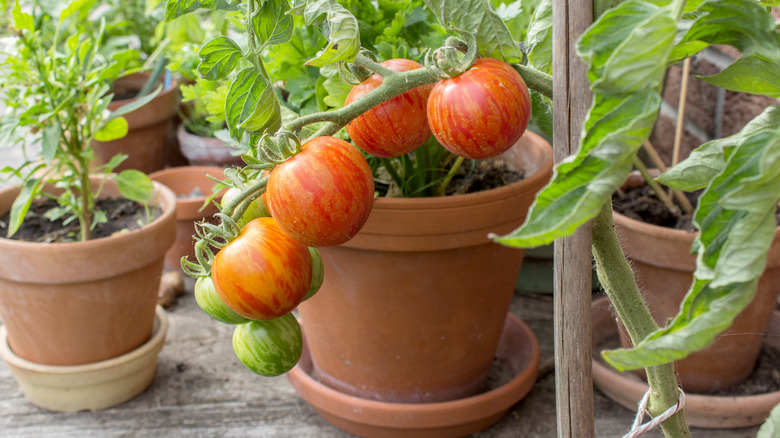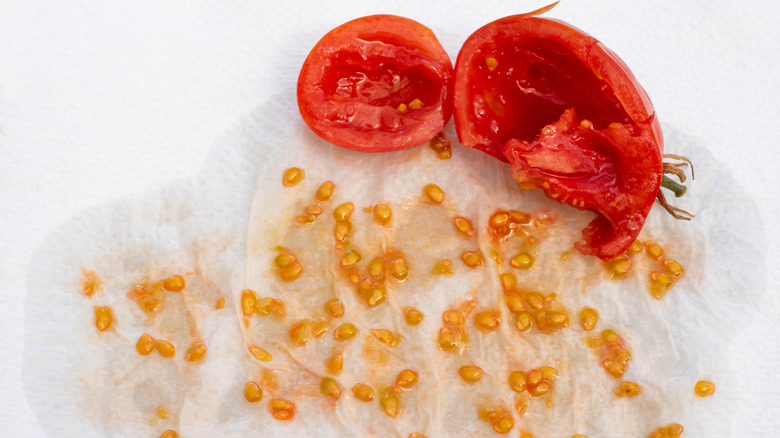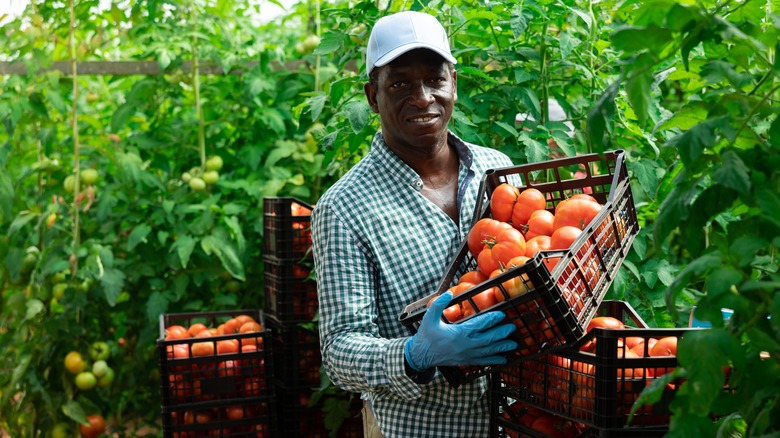Don't Try Regrowing Tomatoes From Store-Bought Produce Without Knowing This First
If you've ever bought an especially good tomato from the grocery store, you may have thought about trying to save a few seeds from it to grow yourself. While these seeds will more than likely grow into tomato plants and will likely even produce fruit, it might not be the best use of your time, energy, and garden space. There is a good chance that the tomatoes grown from these seeds won't taste anything like that amazing tomato you were trying to duplicate.
Most grocery store tomatoes are hybrids, which means they are a cross between two different tomato varieties. As wonderful as they may taste, the plants are considered genetically unstable, meaning that tomatoes grown from their seeds won't share many traits. This differs from heirloom tomatoes, which are able to predictably pass down genes and traits from generation to generation. This doesn't mean you can't grow these hybrid grocery store tomato seeds and see what surprises you get, but if you want a better chance of tasty tomatoes at the end of the season, it is best to either buy tomato seeds from top seed companies or only save seeds from heirloom tomatoes. Even heirloom tomatoes can end up giving you surprises if you don't keep the flower protected with a mesh bag during pollination to ensure the flower pollinates itself instead of being cross-pollinated by another tomato variety in your garden.
Saving tomato seeds
It isn't difficult to save your own tomato seeds, whether they're from an heirloom variety or a hybrid. While it is possible to simply take a thin slice of the tomato with seeds in it and plant that in soil, a better option is to scoop the tomato seeds out of the fruit and allow them to sit in a glass jar with some water in it. Cover the container with a paper towel. Then, after the tomato seeds and liquid have been in the jar for a few days, remove any non viable seeds that are floating on top and strain out the viable seeds from the pulp and liquid. This process should deactivate the chemicals in the tomato that prevent germination. You can plant these seeds immediately if it is the right time to start tomatoes (when the soil hits 60 degrees Fahrenheit).
Of course, it isn't often that you come across the perfect tomato at the perfect time of year to plant it. If you need to save your seeds to start later, you should dry them on a paper towel for around four weeks. Once they are fully dry, you can store the seeds in a glass jar until you are ready to plant them. As long as they are stored in a cool and dry location these seeds should stay viable for several years.
Growing your saved seeds
If all has gone well with seed saving, you should be able to plant and grow your saved seeds just the same as you would tomato seeds from a retailer. To grow juicy tomatoes from seed, plan to start the seeds about two months before your expected last frost date. Tomato seeds need warmth to germinate, so after you have planted your seeds in a moist seed starting mix in a seed starting tray, be sure to put the tray in a warm spot or on a heat mat to encourage germination.
Once the seeds have germinated, be sure to give your new tomato seedlings plenty of light to encourage their growth and make sure to keep their growing medium moist. You can begin giving the seedlings small amounts of diluted water-soluble fertilizer every other week as well. Once your nighttime temperatures are consistently above 60 degrees Fahrenheit, work to harden off your plants and acclimate them to growing outside. After a week or two, your tomatoes, regardless of where you got the seeds, should be ready to be planted in their final location. Be sure to give them plenty of sun, rich well, well-draining soil, water, and support, and you should be seeing the fruits of your labor in no time.


